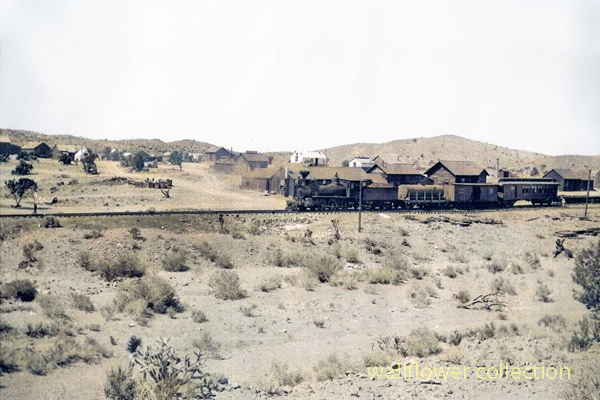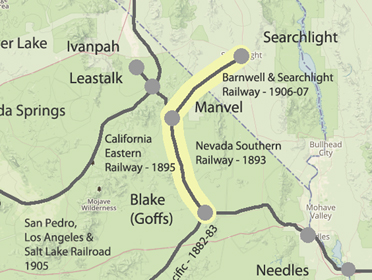Manvel/Barnwell

Barnwell - Searchlight Railroad, NPS photo- colorized
By the late 1880s, discoveries were being made throughout the eastern Mojave Desert. Among the most promising places were the Montgomery and Yellow Pine districts. In the Yellow Pine district, about 40 miles north of the New York Mountains, Samuel S. Godbe was opening up a silver-lead deposit.
Isaac G. Blake, a mining magnate in Denver, was especially interested in the Sagamore Mine, a deposit of lead, silver, copper, and zinc in the New York Mountains, just inside California. He also liked the potential of the Yellow Pine Mining District, which contained veins of silver, lead, and gold. In December of 1892, Blake began work on a branch line from Goffs: the Nevada Southern Railway. (Goffs would be renamed Blake in 1894.) Most of the route passed over a gently sloping plain. In late February, 1893, the grade reached the foot of the New York Mountains, 25 miles north of Goffs.
A construction camp named Purdy, after Warren G. Purdy, one of Blake’s partners, was built there. A post office opened in late April, 1893. It was named after Allen Manvel, the late president of the Santa Fé Railway. Several businesses (probably housed in tents) opened about May. In early September, C. K. Dixon received a license to operate a saloon there.
A camp also arose at the Sagamore, where 80 men worked in early 1893. E. H. Leibey kept a grocery store there. H. Ramsey moved his business from Providence to the Sagamore, where, in early September, he received a liquor license, probably for a store. Leibey soon moved.
The onset of a long depression forced the Nevada Southern to halt most work in June of 1893, but the construction of a grade over the New York Mountains continued. About five miles beyond Purdy, the railroad founded another camp. It was named Summit, which stood on a juniper-covered mesa at 4,800 feet. In early June, the county supervisors granted licenses for two saloons; Virgil W. Earp owned one of them. Scheduled trains began running there about August, when the businesses of Purdy were moved to Summit. The camp supported one store, owned by R. J. Halsey. In early October, the Manvel post office, which had been suspended for two weeks, was re-established at Summit; the postmaster was E. H. Leibey, who had moved his business from the Sagamore.
Manvel served as the nearest railhead for several widely scattered mining camps, including Vanderbilt, Goodsprings, Crescent, and Montgomery. A shipment to the Montgomery mines, 125 miles northwest, for example, totaled 25 tons. The trade increased in the late 1890s, when the Copper World Mine was opened up and gold was discovered 20 miles to the east, at what became Searchlight, Nevada. By early 1898, Manvel supported a flour, grain, and lumber dealer, a general store, a hotel, a blacksmith, the post office, and a stage line running to Montgomery. A school district was organized in January, 1900. In early 1902, the Nevada Southern completed a 15-mile extension into the Ivanpah Valley, to serve as the shipping point for the Copper World Mine. The railhead was named Ivanpah. (Several months later, the Santa Fé Railway bought the Nevada Southern and renamed it the California Eastern Railway.) At Searchlight, meanwhile, the production steadily increased.
As the main shipping point for Searchlight, Manvel was busy. The town contained a depot and telegraph office, a freight-forwarding house, and an agency of Wells, Fargo & Company. The increased business at the post office made it eligible to sell money orders. The Brown-Gosney Company’s store transacted several thousand dollars worth of business a day. T. A. Brown, the co-founder of the store, organized a telephone system; started several freight lines and a stage line; and opened branches in several nearby camps and towns. (To prevent confusion with a town in Texas, Manvel was renamed Barnwell in early 1907.)
As long as Manvel remained the only railhead in that region, its importance remained secure. But in early 1902, the railroad extended its line into the Ivanpah Valley, where it established a shipping point for the Copper World Mine. Then, in early 1905, the San Pedro, Los Angeles & Salt Lake Railroad was completed. The line passed only 20 miles from Searchlight and 15 miles from the Copper World Mine. The management of the Santa Fé opposed building lines into mining districts. But in early 1907, the company finally completed a 23-mile extension to Searchlight: the Barnwell & Searchlight Railway, just as Searchlight’s production plunged. A depression followed in October. In Manvel, blue pieces of scrip were introduced as money; families began to drift away. Several miles away, in the Castle Mountains, Hart boomed in early 1908, but the shipping point was established at Hitt, a siding and freight house on the Barnwell & Searchlight. That September, a fire destroyed most of Barnwell’s business district, including the depot and the Brown-Gosney Company’s store. The company, which had moved its headquarters to Searchlight, closed its store in Barnwell in February, 1910. Another fire followed, in May. The production at Searchlight fell to $23,000 in 1911. T. A. Brown moved his family away in 1912. The railroad closed its agency in 1914; the post office was discontinued in April, 1915; and the school district was abolished about 1918. All train service was discontinued in late 1923, and the rails were torn up.
